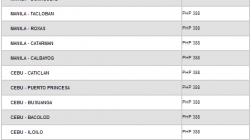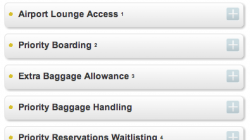There has been lots of buzz recently surrounding Philippine Airlines (PAL) and their latest plans to launch flights to Brazil.
Last week, the Philippine Flight Network, a Filipino-based airline and aviation news source, revealed that the two countries just signed their first ever air service agreement, which should hopefully pave the way for PAL to secure permission to fly to Latin America.
According to the article, the agreement authorizes one carrier from each country (in which case, PAL is the designated airline for the Philippines and TAM for Brazil) rights to operate seven weekly flights from Manila to either São Paulo (GRU) or Rio de Janeiro (GIG), with fifth freedom traffic rights to any third country points as a stopver point between those stations.
Currently, there are no aircraft in service that can capably fly nonstop between Brazil and the Philippines, since such a route is over 12,000 NM in distance, so a stopover somewhere along the way is absolutely necessary.
Initially, the stopover point was rumored to be Abu Dhabi or Dubai, as PAL already holds fifth freedom rights for these two cities. Johannesburg and Addis Ababa, Ethiopia were also rumored to be possible contenders as well.
However, the latest circulation on the rumor mills is that Los Angeles has been selected as the winner, and that the President of PAL, Ramon Ang, revealed that the airline is already processing regulatory approvals and awaiting clearance to launch the route in 2014. In addition, São Paulo has been chosen over Rio as the final terminating point in Brazil.
As such, my guess is that the route will operate Manila – Los Angeles – São Paulo on the eastbound sector, and São Paulo – Los Angeles – Guam – Manila on the westbound sector. PAL already flies to LAX from Manila, but westbound flights currently have to make a technical fuel stop in Guam, so I would imagine this will hold place even once São Paulo comes online.
There are a lot of interesting discussion points associated with this route development. To be completely truthful, while the news is somewhat exciting to watch and monitor as it progresses, a lot of the surrounding business logic behind it has left me scratching my head.
According to the latest article published in the Philippine Flight Network, Los Angeles emerged as the victor in this situation because it is one of PAL’s most profitable long-haul markets and there are a large number of Filipinos living in California who would like to take advantage of this new flight to Brazil given that Filipino tourists are permitted to visit Brazil for 90 days without a visa.
PAL is also eager to expand their international footprint, as it has lost a lot of its flex in the domestic and short-haul market to successful low-cost entrants such as Cebu Pacific Airways, and expanding in the long-haul sphere is part of its plans to return to consistent profitability in 2014 and beyond.
Still, the first major gray area concerns market demand between the two nations. Interestingly, the news sources candidly mention that there are not many visitors between Brazil and the Philippines. Roughly 20,000 people travel between Manila and São Paulo/Rio de Janeiro each year, which amounts to approximately 54 people per day. That is an exceptionally small volume of potential traffic to work with to fill up an Airbus A340.
Although trade ties and traffic volumes between Brazil and the Philippines are growing annually, the growth rate is still relatively small, and the passenger makeup particularly low-yielding, to warrant the need to cover such a large distance using a fairly fuel-inefficient aircraft. Is PAL really feeling pressurized to send its own metal to the largest country in Latin America for glamour purposes, even if the ties between its native country and Brazil are still relatively paper-thin?
Secondly, PAL says it wants to target Filipinos based in LA to offer them the chance to fly to Brazil without needing to obtain a visa. Again, a huge gap exists here in terms of identifying whether the majority of these people are actually Filipino citizens residing in the U.S., or U.S. citizens of Filipino descent If they fall into the former category, then the logic makes sense, but if not, then they will be required to obtain visas to travel to Brazil, since it is policy for all U.S. citizens entering Brazil regardless of ethnic background.
Even if the LA-based Filipino is a U.S. resident with Filipino citizenship, are a large demographic of people with such origin traveling to Brazil in large volumes these days? I have my sincere doubts. Possibly in New York or Miami, yes, but not Los Angeles. At present, there is only one airline that flies between California and Brazil, which is Korean Air with its thrice-weekly service between LAX and GRU, although American Airlines has applied to launch daily LAX-GRU flights later this year, so the number of daily Available Seat Miles is set to grow. Still, I have always been under the impression that California – Brazil is a pretty low-yielding market.
Moreover, if PAL wants to target tourism traffic out of California, why should PAL select São Paulo, which is a more business-oriented destination, over Rio de Janeiro, a leisure-driven market?
Thirdly, even despite the lack of visa requirement traveling between Brazil and the Philippines, a stopover in the U.S. still requires a transit visa, as is required for Brazilian and Filipino citizens making a connection in any U.S. port of entry. Existing 1-stop options between the two countries via the UAE, Qatar and Ethiopia do not require transit visas, which of course is going to appeal more to whatever traffic demand exists at present.
Fourthly, the Philippines is currently held at Category II status by the FAA, which sets restrictions on expanding in the U.S. due to safety ratings. Until the Philippines is restored to Category 1, any Filipino carriers cannot adjust schedules nor fleet types operating into the U.S., which obviously will affect the future of this route. Although PAL is confident that restoration to Category 1 will become reality sometime this year, or next year, this is seemingly a very slow-moving process.
In all sincerity, I applaud PAL and their management for thinking outside the box, but I firmly believe this is a pipe dream that is destined to be a failure, even if it is successful in getting off the ground. There are probably ulterior motives here, the most salient being that PAL wants to get its foot through the door in securing market share between the U.S. and Brazil. My guess would be that IF PAL were to go live with LAX-GRU, it would do some damage to American, and possibly Korean, by flooding the market with cheap fares.
And, this also can be seen as an ego move on PAL’s part to get some action at São Paulo, which is a hot airport these days. A few Asian flag carriers currently serve GRU, such as Singapore Airlines (from Singapore, via Barcelona), Air China (from Beijing, via Madrid) and as mentioned previously, Korean Air via LAX. Again, it would be a glamorous distinction for PAL, but likely one that won’t come without consequences from dedicating a large volume of resources towards something that won’t deliver promising return on investment in the short-term.
In summary, if there really was a rational business case for PAL to gain access to Brazil, it makes far more sense for PAL to codeshare with Etihad, Emirates, Ethiopian, American, etc. on 1-stop options as a lower-risk approach. However, given the number of obstacles PAL has to overcome as-is with Category 1 and other items on the agenda, we’ll see if this one actually takes flight.
Stay tuned…


